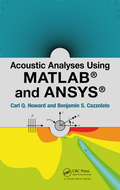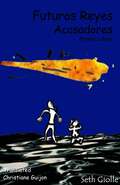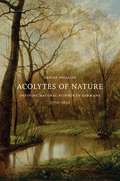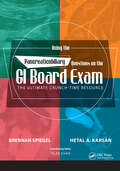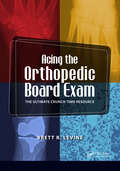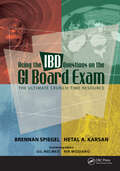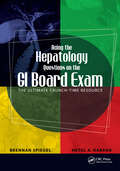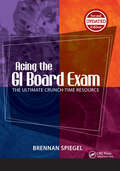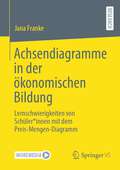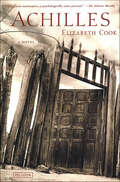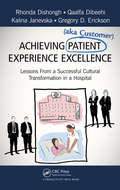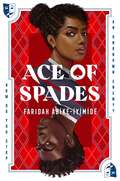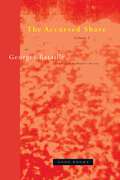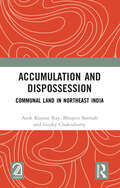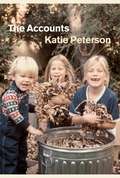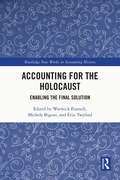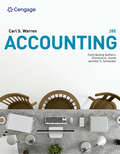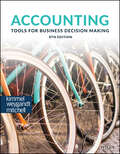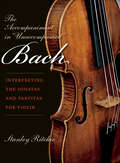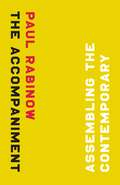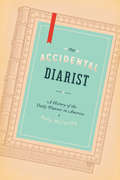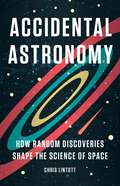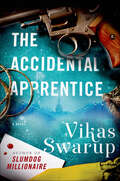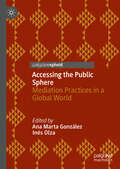- Table View
- List View
Acoustic Analyses Using Matlab and Ansys
by Carl Howard Benjamin CazzolatoThis book describes the use of ANSYS finite element analysis software and MATLAB to solve acoustic problems. These range from simple textbook problems, to complex ones that can only be solved using FEA software. The book includes instructions on relevant mathematical modelling, and hints on the use of ANSYS software. The MATLAB source code provides readers with valuable tools for doing their own validations, and is available for download. The book provides practical training in the use of FEA for basic modelling and solving acoustic problems.
Acosadores: Primer Libro (Futuros Reyes #1)
by Seth GiolleAngelina, Gordon y Simon son tres jóvenes magos nacidos en un mundo que ha sido invadido. La magia regresó al hombre un día fatídico trayendo regalos mágicos, pero el paso del cometa también trajo criaturas de otra dimensión que invadieron nuestro mundo y pusieron a la humanidad de rodillas. Cuando las criaturas fueron vencidas, los humanos se volvieron contra los magos culpándolos por el ataque, y los magos huyeron dejando al hombre reconstruirse a partir de los escombros. Ha pasado mucho tiempo desde aquel día y el hombre no ha reconstruido mucho. Básicamente vive de los humos del viejo mundo. Los magos y hechiceros son cazados y asesinados. Angelina sabe que un mago ha bajado del norte para rescatarlos, y parece digno de confianza, pero se enfrenta a algo muy similar a esas bestias oscuras de antaño, las que se suponía que estaban todas muertas, y el pueblo se está volviendo loco. Si los tres jóvenes quieren salir de la ciudad y dirigirse al el norte, hacia un lugar seguro, necesitarán mucho coraje e ingenio. ¡Y mucha magia!
Acolytes of Nature: Defining Natural Science in Germany, 1770–1850
by Denise PhillipsAlthough many of the practical and intellectual traditions that make up modern science date back centuries, the category of “science” itself is a relative novelty. In the early eighteenth century, the modern German word that would later mean “science,” naturwissenschaft, was not even included in dictionaries. By 1850, however, the term was in use everywhere. Acolytes of Nature follows the emergence of this important new category within German-speaking Europe, tracing its rise from an insignificant eighteenth-century neologism to a defining rallying cry of modern German culture. Today’s notion of a unified natural science has been deemed an invention of the mid-nineteenth century. Yet what Denise Phillips reveals here is that the idea of naturwissenschaft acquired a prominent place in German public life several decades earlier. Phillips uncovers the evolving outlines of the category of natural science and examines why Germans of varied social station and intellectual commitments came to find this label useful. An expanding education system, an increasingly vibrant consumer culture and urban social life, the early stages of industrialization, and the emergence of a liberal political movement all fundamentally altered the world in which educated Germans lived, and also reshaped the way they classified knowledge.
Acing the Pancreaticobiliary Questions on the GI Board Exam: The Ultimate Crunch-Time Resource
by Brennan Spiegel Hetal KarsanThe Pancreas. It’s not very large, but it packs a punch. You gotta know about the pancreas. Then toss in the crazy complexities of the biliary system and there’s is a lot to learn to manage your patients. In this latest book in the Acing GI Board Exam Series, the focus is on the pancreas and biliary tree and how they can cause trouble. In today’s fast-paced world, it is a struggle to keep up with the burgeoning panc-bil literature. Until now, there has been no single, slim, but high-yield volume that summarizes the panc-bil you really need to know for the board exam. This review book keeps you on your toes and sharp for everyday clinical practice too. What is the best way to effectively prepare and study, if reading multiple resources can’t seem to fit into your daily schedule? The answer to your study questions (and study time!) can be found inside Acing the Pancreaticobiliary Questions on the GI Board Exam: The Ultimate Crunch-Time Resource. Dr. Brennan MR Spiegel and Dr. Hetal A. Karsan have collected every pearl of wisdom, high-yield factlet, panc-bil "board buzzword," and classic imaging study they could muster, all while keeping Acing thePancreaticobiliary Questions on the GI Board Exam a manageable size. Why You Will Need to Read Acing the Pancreaticobiliary Questions on the GI Board Exam: Carefully vetted board-style clinical vignettes with color images Comprehensive yet succinct answers using a high-yield format Emphasis on key clinical pearls and “board buzzwords” Answers to classic board “threshold values” questions that you need to know but always seem to forget Rapid-fire, crunch-time exam with 150 classic one-liners Acing thePancreaticobiliary Questions on the GI Board Exam fills the unmet need in board review by presenting time-tested and high-yield information in a rational, useful, and contextually appropriate format suitable studying for the board exams and preparing for the recertification exam. Chapters Include: A compilation of general lessons learned from past test-takers “Tough Stuff” board review vignettes Board review “Clinical Threshold Values” “Crunch-Time” Self-Test and Answer Guide—time to get your game on! With its focus on pearl after pearl, emphasis on images, and attention to high-yield “tough stuff” vignettes you don’t know the answers to (yet), Acing the Pancreaticobiliary Questions on the GI Board Exam is truly the ultimate crunch-time resource for acing the GI board examination, taking recertifying examinations, looking good on clerkship rounds, or for just challenging yourself with interesting and entertaining vignettes.
Acing the Orthopedic Board Exam: The Ultimate Crunch Time Resource
by Brett LevineIn today’s fast-paced world, orthopedic residents and fellows struggle to find the time to study for the board exams, prepare for the recertification exam, prepare for the Orthopedic In-Training Examination, prepare for teaching rounds, or just plain read. What is the best way to effectively prepare and study, if reading multiple resources can’t seem to fit into your daily schedule? The answer to your study questions (and study time!) can be found inside, Acing the Orthopedic Board Exam: The Ultimate Crunch-Time Resource Until now, there has been no single high-yield volume that summarizes the “tough stuff” on the orthopedic board and recertification exams. Acing the Orthopedic Board Exam: The Ultimate Crunch-Time Resource is meant to give an edge on the really tough questions found on exams, rather than be a simple review of the basics. Why you need Acing the Orthopedic Board Exam: • Carefully vetted board-style vignettes with color images • Comprehensive yet succinct answers using a high-yield format • Emphasis on key clinical pearls and “Board Buzzwords”Acing the Orthopedic Board Exam by Dr. Brett R. Levine fills the unmet need in board review by presenting time-tested and high-yield information in a rational, useful, and contextually appropriate format.Chapters include: • A compilation of general lessons learned from past test takers • “Tough Stuff” board review vignettes • “Crunch-Time” Self-Test—Time to get Your Game On! With its focus on pearl after pearl, emphasis on images, and attention to high-yield “tough stuff” vignettes you don’t know the answers to (yet), Acing the Orthopedic Board Exam: The Ultimate Crunch-Time Resource will help you ace the orthopedic board and recertifying examinations, look good on clerkship rounds, simply challenge you with interesting and entertaining vignettes, and take optimal care of your patients in clinical practice.
Acing the IBD Questions on the GI Board Exam: The Ultimate Crunch-Time Resource
by Brennan Spiegel Hetal KarsanThe world of inflammatory bowel disease (IBD) knowledge is vast. Within that world is a sub-set of knowledge that is especially important for everyday clinical care. And a sub-set of that is testable for the Board exam. The testable material includes time-honored, locked-in-stone, mostly uncontroversial facts that have withstood the test of time. The answer to your study questions (and reduction of your study time!) can be found inside Acing the IBD Questions on the GI Board Exam: The Ultimate Crunch-Time ResourceUntil now, there has been no single, slim, but high-yield volume that summarizes the IBD you really need to know for the board exams, preparing for rounds, or just plain read. The authors have collected every pearl of wisdom, high-yield factlet, IBD "Board buzzword," micrograph, and classic imaging study they could muster, all while keeping Acing the IBD Questions on the GI Board Exam: The Ultimate Crunch-Time Resource a manageable size.In today’s fast-paced world it is hard to keep up with the burgeoning IBD literature. Traditional textbooks usually feature long and detailed discussions that don’t directly address board and recertification exams. On the flip side, many board review manuals provide lists and bullet points lacking sufficient background and context. Acing the IBD Questions on the GI Board Exam by Drs. Brennan Spiegel and Hetal Karsan, fills the unmet need in board review by presenting time-tested and high-yield information in a rational, useful, and contextually appropriate format.Why you need Acing the IBD Questions on the GI Board Exam:• Focuses exclusively on inflammatory bowel disease review• Carefully vetted board-style vignettes with color images• Comprehensive yet succinct answers using a high-yield format• Emphasis on key clinical pearls and “Board Buzzwords”• Rapid-fire crunch time exam with 140 classic one-liners such as:Diarrhea + mucus-filled cysts throughout colon = ?The vastly evolving world of IBD includes genetic breakthroughs and new medications with different risks and benefits. Acing the IBD Questions on the GI Board Exam has it all in one resource that includes endoscopic, histologic, radiologic and dermatologic manifestations, as well as with great images and tables to help guide the reader.Chapters include:• A compilation of general lessons learned from past test takers• “Tough Stuff” board review vignettes• “Crunch-Time” Self-Test—Time to get Your Game On! With its focus on pearl after pearl, emphasis on images, and attention to high-yield “tough stuff” vignettes you don’t know the answers to (yet), Acing the IBD Questions on the GI Board Exam: The Ultimate Crunch-Time Resource will help you ace the GI and recertifying examinations, look good on clerkship rounds, simply challenge you with interesting and entertaining vignettes, and take optimal care of your IBD patients in clinical practice.
Acing the Hepatology Questions on the GI Board Exam: The Ultimate Crunch-Time Resource
by Brennan Spiegel Hetal KarsanHepatology is an expanding field - it's hard to keep up. The liver has been sitting there the whole time, but the knowledge surrounding this perplexing organ is exploding; this makes it hard to prepare for board and recertification exams, where 1 in every 4 questions pertains to hepatology. Until now, there has been no single, slim, but high-yield volume that summarises the hepatology you need to know for the boards. This book has it nailed. The authors have collected every pearl of wisdom, high-yield factlet, liver ""board buzzword,"" hepatic micrograph, and classic liver imaging study they could muster, all while keeping the book a manageable size - because who has time for more than manageable when you're busy?The answer to your study questions (and study time!) can be found inside: Acing the Hepatology Questions on the GI Board Exam: The Ultimate Crunch-Time Resource.Traditional textbooks usually feature long and detailed discussions that are not directly related to Board and recertification exams. On the flip side, many Board review manuals provide lists and bullet points lacking sufficient background and context. Inside Acing the Hepatology Questions on the GI Board Exam, Drs. Brennan Spiegel and Hetal Karsan present time-tested and high-yield information in a rational, useful, and contextually appealing format.With its focus on pearl after pearl, emphasis on images, and attention to high-yield "tough stuff" vignettes you don't know the answers to (yet), Acing the Hepatology Questions on the GI Board Exam is truly the ultimate crunch-time resource for acing often vexing liver section of the examination, taking recertifying examinations, looking good on clerkship rounds, or for just challenging yourself with interesting and entertaining vignettes.
Acing the GI Board Exam: The Ultimate Crunch-Time Resource
by Brennan SpiegelAcing the GI Board Exam: The Ultimate Crunch-Time Resource has been updated into a Second Edition. The Second Edition contains new vignettes, a discussion on Maintenance of Certification (MOC) Exam, and discussion on test relevancy for residency rotations! In today’s fast-paced world, gastroenterology and hepatology residents and fellows struggle to find the time to study for the board exams, prepare for the recertification exam, prepare for teaching rounds, or just plain read. What is the best way to effectively prepare and study, if reading multiple resources can’t seem to fit into your daily schedule? The answer to your study questions (and study time!) can be found inside the newly updated Second Edition of Acing the GI Board Exam: The Ultimate Crunch-Time Resource! Why You Will Need to Read Acing the GI Board Exam, Second Edition: New! 41 new and carefully vetted board-style vignettes with color images New! Brief discussion on the Maintenance of Certification (MOC) Exam New! Discussion on test relevancy for residency rotations Comprehensive yet succinct answers using a high-yield format Emphasis on key clinical pearls and “board buzzwords” Answers to classic board “threshold values” questions that you need to know but always seem to forget Rapid-fire, crunch-time exam with 200 classic one-liners Dr. Brennan Spiegel has collected every pearl of wisdom, high-yield factlet, "Board buzzword," micrograph, and classic imaging study he could muster, all while keeping Acing the GI Board Exam: The Ultimate Crunch-Time Resource, Second Edition a manageable size. Acing the GI Board Exam, Second Edition fills the unmet need in board review by presenting time-tested and high-yield information in a rational, useful, and contextually appropriate format suitable studying for the board exams and preparing for the recertification exam.Chapters Include: A compilation of general lessons learned from past test-takers “Tough Stuff” board review vignettes Board review “Clinical Threshold Values” “Crunch-Time” Self-Test and Answer Guide—time to get your game on! With its focus on pearl after pearl, emphasis on images, and attention to high-yield “tough stuff” vignettes you don’t know the answers to (yet), Acing the GI Board Exam, Second Edition is truly the ultimate crunch-time resource for acing the GI and Hepatology examination, taking recertifying examinations, looking good on clerkship rounds, or for just challenging yourself with interesting and entertaining vignettes.
Achsendiagramme in der ökonomischen Bildung: Lernschwierigkeiten von Schüler*innen mit dem Preis-Mengen-Diagramm
by Jana FrankeÖkonomische Modelle werden durch bewusste Reduktion der Komplexität des Betrachteten mit dem Ziel des Erkenntnisgewinns entwickelt. Mithilfe von mathematischen Modellierungen können ökonomische Modelle exakter gefasst werden. Dieses Resultat ist ein wichtiges Werkzeug bei der Ermittlung und Darstellung von Systemzusammenhängen. Durch die Visualisierung der mathematischen Modellierungen mit dem Achsendiagramm werden abstrakte Zusammenhänge erkennbar und diskutierbar. Deshalb finden ökonomische Achsendiagramme in der Schule unter anderem als Hilfsmittel zur systematischen Betrachtung einzelner Einflussfaktoren eines komplexen Interaktionssystems, wie beispielsweise der Preisbildung auf Märkten, Einsatz. Die Visualisierung des ökonomischen Modells der Preisbildung auf Märkten mithilfe des Preis-Mengen-Diagramms kann dabei die ökonomischen Verständnisprozesse fördern, sie aber auch behindern. Inwieweit das Preis-Mengen-Diagramm somit Hilfsmittel und Hürde im Wirtschaftsunterricht darstellt, wird in diesem Buch untersucht. Dafür werden Lernschwierigkeiten von Schüler*innen beim Umgang mit und dem Wissen über die mathematische Modellierung des ökonomischen Modells der Preisbildung im vollkommenen Markt und dessen Visualisierung durch das Preis-Mengen-Diagramm identifiziert. Darauf aufbauend werden Implikationen für den Wirtschaftsunterricht abgeleitet.
Achilles: A Novel
by Elizabeth CookThis powerful, passionate, and beautifully crafted retelling of the epic tale of Achilles re-creates Homer's fated hero in a new and striking reality. Born of the Sea nymph Thetis by the mortal King Peleus, and hidden as a girl until Odysseus discovers him, Achilles becomes the Greeks' greatest warrior at Troy. Into his story comes a cast of fascinating characters—among them, Hector, Helen, Penthiseleia the Amazon Queen, and the centaur Chiron; and finally John Keats, whose writings form the basis of a meditation on the nature of identity and shared experience. An unforgettable and deeply moving work of fiction, Achilles is also an affirmation of the story's enduring power to reach across centuries and cultures to the core of our imagination.
Achieving Patient (aka Customer) Experience Excellence: Lessons From a Successful Cultural Transformation in a Hospital
by Rhonda Dishongh Qaalfa Dibeehi Kalina Janevska Gregory D. EricksonWritten by internationally acknowledged experts in the customer and patient experience movement, this book clearly outlines the principles and development phases of a great customer experience transformation. Using an engaging story, it allows readers to follow the journey of Community General, a healthcare organization that went from struggling to being nationally recognized for its performance and customer satisfaction. Demonstrating how Community General was able to achieve its cultural transformation, the book presents valuable lessons learned that can be applied across a wide range of industries.
Ace of Spades
by Faridah Àbíké-ÍyímídéGossip Girl meets Get Out in Ace of Spades, a YA contemporary thriller by debut author Faridah Àbíké-Íyímídé about two students, Devon & Chiamaka, and their struggles against an anonymous bully. All you need to know is . . . I’m here to divide and conquer. Like all great tyrants do. —Aces When two Niveus Private Academy students, Devon Richards and Chiamaka Adebayo, are selected to be part of the elite school’s senior class prefects, it looks like their year is off to an amazing start. After all, not only does it look great on college applications, but it officially puts each of them in the running for valedictorian, too.Shortly after the announcement is made, though, someone who goes by Aces begins using anonymous text messages to reveal secrets about the two of them that turn their lives upside down and threaten every aspect of their carefully planned futures.As Aces shows no sign of stopping, what seemed like a sick prank quickly turns into a dangerous game, with all the cards stacked against them. Can Devon and Chiamaka stop Aces before things become incredibly deadly?With heart-pounding suspense and relevant social commentary comes a high-octane thriller from debut author Faridah Àbíké-Íyímídé.
The Accursed Share, Volume I
by Georges BatailleFrom the acclaimed French philosopher, intellectual, and novelist, a brilliant account of the social and economic costs of civilizationIn this important work, Georges Bataille uses his novel economic theory as the basis for an incisive inquiry into the very nature of civilization. He introduces here his concept of the accursed share, the surplus energy that any system, natural or cultural, must expend; it is this expenditure, according to Bataille, that most clearly defines a society. His examples include sacrifice among the Aztecs, potlatch among the Northwest Coast Indians, military conquest in Islam, and Buddhist monasticism in Tibet.In this way, Bataille proposes a theory of a &“general economy&” based on excess and exuberance that radically revises conventional economic models of scarcity and utility. A brilliant blend of economics and aesthetics, ethics and anthropology, The Accursed Share provides an excellent introduction to Bataille&’s philosophic work. It will be of particular interest not only to readers of his fiction and essays but also to cultural theorists, anthropologists, and economists of all schools.
Accumulation and Dispossession: Communal Land in Northeast India
by Gorky Chakraborty Asok Kumar Ray Bhupen SarmahThis book sketches a road map of privatisation, accumulation and dispossession of communal land in the tribal areas of North East India from pre-colonial times to the neo-liberal era.Spread over five chapters, this study unfolds the privatisation of communal land in the backdrop of a larger theoretical and historical canvas. It deals with the different institutional modes of privatisation, accumulation and dispossession of communal land, the changes in land use and cropping patterns, the changes in land relations and the land-based identity of the tribal community as a result. The conclusive chapter makes a broader reflection of the grand narrative of privatisation, accumulation and dispossession of communal land in North East India.This title is co-published with Aakar Books. Print edition not for sale in South Asia (India, Sri Lanka, Nepal, Bangladesh, Pakistan and Bhutan)
The Accounts (Phoenix Poets Ser.)
by Katie PetersonThe death of a mother alters forever a family’s story of itself. Indeed, it taxes the ability of a family to tell that story at all. The Accounts narrates the struggle to speak with any clear understanding in the wake of that loss. The title poem attempts three explanations of the departure of a life from the earth—a physical account, a psychological account, and a spiritual account. It is embedded in a long narrative sequence that tries to state plainly the facts of the last days of the mother’s life, in a room that formerly housed a television, next to a California backyard. The visual focus of that sequence, a robin’s nest, poised above the family home, sings in a kind of lament, giving its own version of ways we can see the transformation of the dying into the dead. In other poems, called “Arguments,” two voices exchange uncertain truths about subjects as high as heaven and as low as crime. Grief is a problem that cannot be solved by thinking, but that doesn’t stop the mind, which relentlessly carries on, trying in vain to settle its accounts. The death of a well-loved person creates a debt that can never be repaid. It reminds the living of our own psychological debts to each other, and to the dead. In this sense, the death of this particular mother and the transformation of this particular family are evocative of a greater struggle against any changing reality, and the loss of all beautiful and passing forms of order.
Accounting for the Holocaust: Enabling the Final Solution (Routledge New Works in Accounting History)
by Michele Bigoni Warwick Funnell Erin TwyfordAccounting for the Holocaust: Enabling the Final Solution reveals how accounting practices allowed the attempted annihilation of Jews by the German Nazis and the Italian Fascists to be carried out with machine-like efficiency and devoid of any moral considerations.This largely hidden aspect of the Holocaust will allow a wide range of readers, both academic and across many sectors of the general population, to understand how the systematic murder of more than six million Jews was expedited by accounting practices and the information that these produced by allowing the humanity of those killed to be denied when they became mere numbers in a process. Readers will gain a new understanding of how the enactment of the scale of the Holocaust was made possible by the way in which accounting practices as “technologies of death” were used to reduce Jews to a life without value. The numerical calculations, techniques, and reports that constitute accounting practices allowed the systematic murder of Jews to be drained of any considerations that would imply that the numbers and costings were related to prescient human beings. These technologies of death also allowed those who managed and organised the murder of Jews to absolve themselves of the actual killings.
Accounting
by Carl S. Warren Christine A. Jonick Jennifer S. SchneiderDevelop a strong foundation in accounting that prepares you for future study and success in today's business world with Warren/Jonick/Schneider's leading ACCOUNTING, 28E and CNOWv2 digital resources. This edition connects accounting concepts to the "bigger picture" as chapter-opening schemas clearly demonstrate how each chapter's content fits within the overall framework of the book. The CNOWv2's Journal Entry Tool reinforces this approach by automatically illustrating the impact of transactions on the accounting equation. This book's hallmark presentation of the accounting cycle provides an unmatched foundation for understanding later chapters and future coursework. The authors have carefully streamlined content and improved learning features to ensure you have the understanding of today's accounting and specific tools you need to succeed.
Accounting: Tools For Business Decision Making
by Jerry J. Weygandt Paul D. Kimmel Jill E. MitchellAccounting: Tools for Business Decision Making by Paul Kimmel, Jerry Weygandt, and Jill Mitchell provides a practical introduction to financial and managerial accounting with a focus on how to use accounting information to make business decisions. Through significant course updates, the 8th Edition presents an active, hands-on approach to spark efficient and effective learning and develops the necessary skills to inspire and prepare students to be the accounting and business professionals of tomorrow. <P><P>To ensure maximum understanding, students work through integrated assessment at different levels of difficulty right at the point of learning. The course's varied assessment also presents homework and assessment within real-world contexts to help students understand the why and the how of accounting information and business application. <P><P>Throughout the course, students also work through various hands-on activities including Cookie Creations Cases, Expand Your Critical Thinking Questions, Excel Templates, and Analytics in Action problems, all within the accounting context. These applications all map to chapter material, making it easier for instructors to determine where and how to incorporate key skill development in their syllabus. <P><P>With Kimmel Accounting, students will understand the foundations of introductory accounting and develop the necessary tools for business decision-making, no matter what path they take.
The Accompaniment in "Unaccompanied" Bach: Interpreting the Sonatas and Partitas for Violin (Publications of the Early Music Institute)
by Stanley RitchieKnown around the world for his advocacy of early historical performance and as a skilled violin performer and pedagogue, Stanley Ritchie has developed a technical guide to the interpretation and performance of J. S. Bach's enigmatic sonatas and partitas for solo violin. Unlike typical Baroque compositions, Bach's six solos are uniquely free of accompaniment. To add depth and texture to the pieces, Bach incorporated various techniques to bring out a multitude of voices from four strings and one bow, including arpeggios across strings, multiple stopping, opposing tonal ranges, and deft bowing. Published in 1802, over 80 years after its completion in 1720, Bach's manuscript is without expression marks, leaving the performer to freely interpret the dynamics, fingering, bowings, and articulations. Marshaling a lifetime of experience, Stanley Ritchie provides violinists with deep insights into the interpretation and technicalities at the heart of these challenging pieces.
The Accompaniment: Assembling the Contemporary
by Paul RabinowIn this culmination of his search for anthropological concepts and practices appropriate to the twenty-first century, Paul Rabinow contends that to make sense of the contemporary anthropologists must invent new forms of inquiry. He begins with an extended rumination on what he gained from two of his formative mentors: Michel Foucault and Clifford Geertz. Reflecting on their lives as teachers and thinkers, as well as human beings, he poses questions about their critical limitations, unfulfilled hopes, and the lessons he learned from and with them. This spirit of collaboration animates The Accompaniment, as Rabinow assesses the last ten years of his career, largely spent engaging in a series of intensive experiments in collaborative research and often focused on cutting-edge work in synthetic biology. He candidly details the successes and failures of shifting his teaching practice away from individual projects, placing greater emphasis on participation over observation in research, and designing and using websites as a venue for collaboration. Analyzing these endeavors alongside his efforts to apply an anthropological lens to the natural sciences, Rabinow lays the foundation for an ethically grounded anthropology ready and able to face the challenges of our contemporary world.
The Accidental Diarist: A History of the Daily Planner in America
by Molly McCarthyIn this era of tweets and blogs, it is easy to assume that the self-obsessive recording of daily minutiae is a recent phenomenon. But Americans have been navel-gazing since nearly the beginning of the republic. The daily planner—variously called the daily diary, commercial diary, and portable account book—first emerged in colonial times as a means of telling time, tracking finances, locating the nearest inn, and even planning for the coming winter. They were carried by everyone from George Washington to the soldiers who fought the Civil War. And by the twentieth century, this document had become ubiquitous in the American home as a way of recording a great deal more than simple accounts.In this appealing history of the daily act of self-reckoning, Molly McCarthy explores just how vital these unassuming and easily overlooked stationery staples are to those who use them. From their origins in almanacs and blank books through the nineteenth century and on to the enduring legacy of written introspection, McCarthy has penned an exquisite biography of an almost ubiquitous document that has borne witness to American lives in all of their complexity and mundanity.
Accidental Astronomy: How Random Discoveries Shape the Science of Space
by Chris LintottA "riveting real-life Hitchhiker's Guide to the Galaxy" (The Telegraph) and "whirlwind tour of wondrous celestial phenomena" (The Idler) shows why so much of astronomy comes down to looking up and lucking out If you learn about the scientific method, you learn that first we hypothesize about something we&’ve experienced, and then we look for more of it. This works well enough—but what if you are interested in studying a heretofore unknown comet or supernova? That is the essential problem of the astronomer: the most important discoveries happen without notice! Indeed, as Chris Lintott argues in Accidental Astronomy, luck defines astronomy. Lintott explores the ways in which happenstance shapes how we investigate the sky. To catch a glimpse of a comet, asteroid, or even a sign of alien life, we must be in the right place at the right time. And if we can&’t be there, we must have a team of professionals and amateurs, across the globe, ready to spring into action at a moment&’s—or a night&’s—notice. For any astronomer, regardless of their experience or resources, the first step to discovery is the same: to stare at the sky and wait. A celebration of astronomy, stargazing, and cosmic discovery, Accidental Astronomy offers an irresistible window into how luck defines our knowledge of the skies.
The Accidental Apprentice: A Novel
by Vikas SwarupVikas Swarup, acclaimed author of Slumdog Millionaire and Six Suspects, has written a compelling, suspenseful tale about the lure of money and the power of dreams. The Accidental Apprentice is international crime fiction at its most entertaining.In life you never get what you deserve. You get what you negotiate.A business empire worth ten billion dollars. This is the tantalizing offer made by Vinay Mohan Acharya, one of India's richest men, to Sapna Sinha, a simple salesgirl in an electronics store in downtown Delhi. She can be the next CEO of his incredibly huge and profitable company. There is only one catch—she needs to pass seven tests from the "textbook of life."Thus begins the most challenging journey Sapna has ever undertaken, one that will take her from her swanky showroom to the heat and dust of India's backstreets and villages. Along the way she encounters a host of memorable personalities, from a vain Bollywood superstar to a kleptomaniac Gandhian. But are the seven tests real or is Acharya playing a game driven by a perverse fantasy?
Accessing the Public Sphere: Mediation Practices in a Global World
by Ana Marta González Inés OlzaThis edited volume focuses on the (un)equal access to the public space granted to the various groups that make up hybrid and multicultural societies: i.e. majority vs minority groups, immigrants vs non-immigrants, and so forth. With ‘access to public space’ the authors refer not only to participation through discursive practices in the public arena (e.g. political, social and institutional debates) but also to a full operationalization of the knowledge, habits and opportunities attached to true citizenship. Furthermore, in contexts of inequality and sociocultural conflict, the role of mediators has always been underscored as third-party figures (in)formally acknowledged and authorized–by participants in the interaction and/or external bodies–to set the ground for mutual understanding and foster balanced communication. Such mediation can range from interpreting in legal and medical encounters to dispute-resolution practices in situations of sociocultural clash among groups or individuals. Therefore, as is shown by the contributions in this volume, (intercultural) mediators are key agents in facilitating integration and providing disadvantaged groups with effective tools to gain access to the public sphere.
Accessibility Tests Mathematics
by Daisy Consortium The DIAGRAM Center Standards WGMath Recommendation for EPUB
